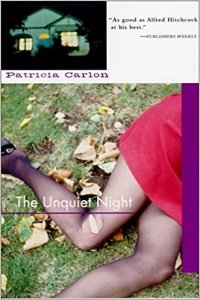
Title: The Unquiet Night
Author:
Patricia Carlon
Pages: 192
Published Date: 1965
Publisher: Soho Crime
Series Details: stand alone
Publisher's Synopsis
Nine-year-old Ann has been taken to a nature reserve by her Aunt Rachel. As they are leaving, she sees a strange young man staring at them. After his panic subsides, the young man, Mart, realizes that they may be able to connect him to the girl he's just strangled.
Hence a game of cat and mouse begins as Mart stalks them and other inhabitants of their small Australian town. Will Ann and her aunt escape?
Review: The Unquiet Night by Patricia Carlon
When Martin Deeford strangles a woman he had just met in a quiet, secluded reserve his reaction is one of disbelief tinged with an uncontrollable fear. The disbelief is driven by the realization that he is now responsible for someone's death and the fear stems from the insecurity stemming from the possibility that he may be caught.
It is this fear plus a growing rage that drives him for the rest of the book. His first action is to calm himself and then he disposes of the body by rolling it into a lake. As he is walking from the water's edge, he receives the nasty shock that he's not alone, Rachel Penghill and her 9 year old niece are also at the reserve. In a panic, he hurries off, but not before allowing the woman to get a good look at his face. Once again he agonises over the fact that he's been seen at the crime scene and can be identified. His solution is to eliminate the witnesses and so he sets off trying to track them down.
As night falls, Martin begins his hunt and the tension slowly begins to build. Patricia Carlon effectively piles on the suspense and leaves us in no doubt that the hunter is verging on the edge of madness. As he gets closer and closer to his quarry, his rage increases with every minor setback, making him even more dangerous.
The early revelation that Martin has had a history of uncontrollable bouts of violence and has had to be removed to a home due to his behavioural problems sets the scene as far as how real the danger is. Every time the focus of the story returns to him there is a noticeable change in tone as an ominous sense of dread hangs over his every move. Carlon's ability to heighten the suspense comes from a simple but very effective device. She makes the reader aware of exactly where the danger is going to come from while keeping the target in the dark allowing the reader's imagination and anticipation to heighten the anxiety over what is about to happen.
Patricia Carlon has captured the confused and panicked thought processes that haunt a person's guilty and already unbalanced mind that has become even more irrational after the shock of committing a violent act. She gets us inside martin's head and makes it chillingly clear that he will stop at nothing. Each scene is set up perfectly to achieve maximum suspense as the innocent Rachel is being stalked throughout the night.
The prose is amazingly spare, to the point where the actual setting of the book - outside the fact that it is in a small town - is virtually ignored. Instead the concentration is focused fairly and squarely on the minds of the characters themselves.
There are a couple of minor holes in the plot towards the end as things are drawn to their climax but I was happy to overlook them, preferring to enjoy what is a well-worked chilling story.
If you enjoy the mind-numbing terror that comes with the fear of the unknown, strangers at the window on a dark and stormy night, this will help keep you awake. It was written and set in the 1960's and is a terrific example of an honest to goodness thriller with a subtlety that is not reliant on the blood and gore scenes that are popular today.
